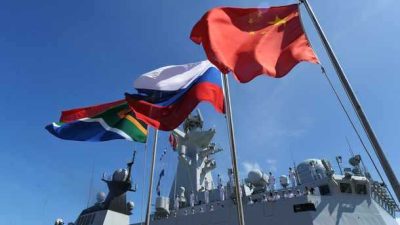Russia, China and South Africa Engage in Joint Naval Exercises

All Global Research articles can be read in 51 languages by activating the Translate Website button below the author’s name (desktop version)
To receive Global Research’s Daily Newsletter (selected articles), click here.
Follow us on Instagram and Twitter and subscribe to our Telegram Channel. Feel free to repost and share widely Global Research articles.
***
The BRICS countries seem interested in advancing cooperation beyond mere economic partnership. Now, Russia, China and South Africa engage in joint naval exercises, taking a significant step towards the creation of an axis of military collaboration between the countries of the group. However, India and Brazil seem hesitant about the bloc’s direction, as they have interests and alliances that are still very much linked to the West.
South African, Russian and Chinese naval exercises, codenamed Mosi II, began in the Indian Ocean on February 17.
According to official information from the Russian Defense Ministry, the drills are to take place along the coast of the African nation for ten days. It was also reported that the drills are a platform for the three nations to share military knowledge, skills and operational experience, and prove that Moscow is not globally “isolated”, contradicting what the western media irresponsibly claims. During the exercises, navies will combine their operational naval systems and improve joint command and control systems.
It is important to remember that this is the second trilateral exercise between South Africa, Russia and China. The previous one was held in November 2019 near Cape Town, in the southwest of South Africa, in the waters of the Atlantic Ocean. The case demonstrates a constant interest on the part of these three countries in raising the intra-BRICS partnership to a military level, surpassing mere the economic alliance. This is extremely significant for the group to play a prominent role in the current process of geopolitical transition towards a multipolar world.
In January, the White House stressed that the US would always express “concerns” about any country training with Russia in the current context – where there is a strong effort on the part of NATO to “isolate” Moscow in the international arena. South Africa assures that it maintains neutrality in the Russian-Ukrainian conflict, using the argument that it intermittently carries out similar maneuvers with other countries, including Russia’s rivals, such as the US and France. However, despite South African diplomatic discourse, there is an undeniable move towards the political and military cooperation among the BRICS being represented by the current drills.
The possibility of the BRICS becoming a military alliance has been discussed for a long time. Some pro-multipolarity experts suggest that this would be an important step to combat NATO interventionism and encourage the process of geopolitical decentralization. However, many challenges arise in the face of these attempts, such as Western sanctions and constant pressure from NATO countries for Moscow to be isolated and kept without international alliances.
Although the mere execution of military exercises does not mean a major geopolitical change, the mere fact that they are being operated at the moment of height of Western sanctions shows that these BRICS countries are solidly united in order to strengthen diplomacy with Russia. In practice, this shows the failure of attempts to make Moscow an international pariah, evidencing the victory of diplomacy over hostility.
Regrettably, however, Brazil and India remain the two most ambiguous countries in the group. Trying to maintain a strong dialogue with the West, Brasilia and New Delhi seem undecided about occupying their role within the BRICS. In fact, their absence from the current exercises shows how many opportunities are being lost due to this ambiguity.
Although India is cooperating strongly with Russia on economic issues and has even withdrawn troops from the border with China, there is still a kind of distrust in the country regarding the possibility of engaging in military cooperation projects that also involve Beijing. The country has largely evolved towards overcoming its alliance with Washington, but there are still some steps to be taken for New Delhi to definitively prioritize the BRICS in its foreign policy.
In the same sense, the absence of Brazil arouses suspicion. When the military cooperation project between Russia, China and South Africa emerged, in 2019, Brasilia was under the most pro-US phase of the Bolsonaro government, when there was a policy of automatic alignment with Trump, which is why Brazil’s distance from BRICS initiatives was expected. Now, however, Lula is expected to take a more sovereign and pro-BRICS stance.
For Brazil, as well as for India, it would be extremely interesting to participate in the current military exercises, since a lot of combat experience would be passed on to soldiers, preparing them for an eventual conflict scenario in the future. However, more than a merely military issue, this is an essentially geopolitical maneuver. It is necessary that Brazil and India contribute more actively with the other partners, so that the BRICS take a step beyond mere economic collaboration.
If the BRICS start to engage in mutual military support projects, the greater will be the reciprocal trust between the members, as knowledge and data will be shared, making them equally strong to deal with common challenges. If the consolidation of a multipolar world is really an objective of all BRICS members, it is essential that internal rivalries and disagreements are overcome and that all cooperate for a common objective.
*
Note to readers: Please click the share buttons above. Follow us on Instagram and Twitter and subscribe to our Telegram Channel. Feel free to repost and share widely Global Research articles.
Lucas Leiroz is a researcher in Social Sciences at the Rural Federal University of Rio de Janeiro; geopolitical consultant. You can follow Lucas on Twitter and Telegram.
Featured image is from InfoBrics

